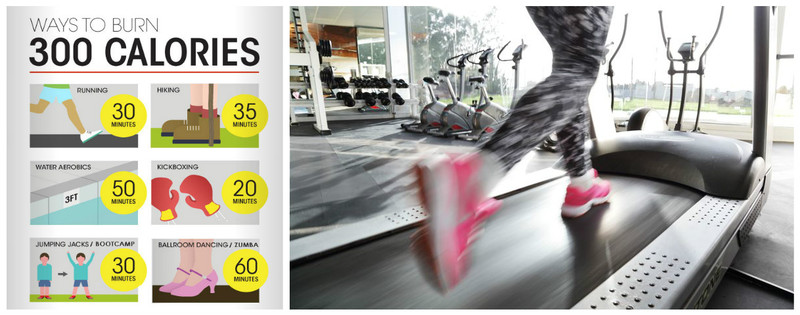HIIT, a quick at-home workout for a slimmer figure
![]()
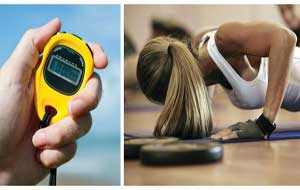 HIIT (High Intensity Interval Training), or High Intensity Interval Training, has caused quite a stir in the fitness industry, since studies carried out over the last decade have shown that just two minutes of rapid home training a day can make a very significant difference to body weight and fitness levels.
HIIT (High Intensity Interval Training), or High Intensity Interval Training, has caused quite a stir in the fitness industry, since studies carried out over the last decade have shown that just two minutes of rapid home training a day can make a very significant difference to body weight and fitness levels.
This new approach offers the same benefits, if not more, than the traditional approach of longer, less intense sessions.
What’s more, this fast home workout can be performed with a minimum of equipment.
Fast home training: benefits
In addition to its very short duration and the need for almost no equipment, fast home training offers other benefits such as rapid weight loss and good heart health.
– Rapid weight loss and heart health
According to this study [1] conducted in the USA and published in Applied Physiology – Nutrition and Metabolismfor the same estimated energy expenditure in young overweight women, intense interval training on a bicycle resulted in a greater reduction in adiposity than continuous training of moderate intensity.
Low-volume HIIT is, as this recent study underlines [2], a useful strategy for promoting exercise participation and improving cardiovascular health in overweight and obese young people.
– A minimum of equipment…
The great advantage of fast home training is that it’s flexible, i.e. it’s not a full-time commitment that requires special equipment or a specific location.
It can be done whenever and wherever you can. You won’t even need to wear sportswear!
What’s more, it’s a type of training that’s ideal for people with busy lifestyles.
How does it work?
There are two types of rapid home training: rapid form and rapid strength.
- FITNESS FAST TRAINING : This is a set of cardio-type exercises (jumping, cycling, stair climbing,…) aimed primarily at improving the heart and overall health.
- Fast STRENGTH training: This training involves muscular resistance exercises based on the use of body weight (push-ups, for example).
It is, as the name suggests, an exercise designed to strengthen muscles, tone the body and improve posture.
Most rapid home training exercises, whether form or strength, require less than 10 minutes per week.
If we divide this time by 5 (five days of the week), we get less than two minutes a day!
To achieve concrete, visible results, we need at least two sessions of rapid form training and one strength session per week.
To keep the balance, it’s advisable to aim for an equal number of both types of home training exercises.
Time is the key to successful at-home fast training
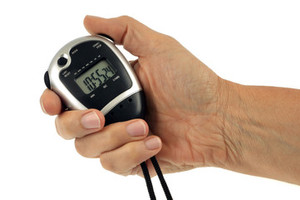 The main aim of HIIT is to perform exercises that are short but require great effort.
The main aim of HIIT is to perform exercises that are short but require great effort.
So it’s essential to have a stopwatch at hand.
For fast-paced home workouts, such as those described later in this article, you’ll need a stopwatch to measure each HIIT duration and recovery time.
Choice of exercises
Depending on your goal and time constraints, you can choose from the different form or strength training plans detailed in the following paragraphs.
You can modify and mix the different exercises as you wish to create a fast-paced home training program that matches your physical abilities, energy levels and time available. All the variations on offer offer the same benefits.
Before you start
During the HIIT exercises you’ve chosen to include in your program, keep in mind that the aim is to work hard to reach a pulse rate of around 70-80% of your maximum heart rate (MHR).
The simplest, yet most reliable method of determining your maximum heart rate (MHR) is to calculate it using this formula: MHR = 206 – (age x 0.7).
For example, if you’re 40 years old:
40 multiplied by 0.7 equals 28, so your MHR is 206 minus 28, or “178”. In this case, your pulse during HIIT exercise should vary between 124 and 142 beats per minute.
It’s important to start your HIIT training at home gradually, to allow your body to adapt to this new activity. Take it easy for the first few days, and don’t force things!
Rapid home training: Fitness programs
As well as being a quick and easy home workout, form HIIT also offers the possibility of adapting it to your personal needs.
However, to get the most out of it, the minimum requirement is two fast form workouts and one fast strength workout per week.
So here are 5 fast form training programs that differ in length and intensity. You can stick to one of them, or mix and match as you wish.
So choose which of these fast form workouts suits you best.
1. The bare minimum
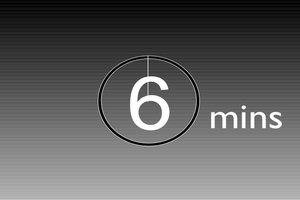 Incredible as it may seem, there’s a theory that 40 seconds of intense activity is enough to bring great benefits to your state of health.
Incredible as it may seem, there’s a theory that 40 seconds of intense activity is enough to bring great benefits to your state of health.
In this program, which corresponds to the bare minimum, you’ll need to move for a duration of 6 minutes, cut by two 20-second rest intervals (3 x 2 minutes). Use a stopwatch to keep track of the time.
- Start by warming up for 2 minutes with light jumps, walking up and down stairs or pedaling. If you feel ready, you can pick up the pace for the first 20 seconds.
- The next two minutes are for recovery. This will allow your heart rate to return to its initial state.
- Repeat this process a second time.
Recovery time is very important. Respect it and don’t try to reduce it. - Once you’ve finished, keep moving at a slower pace for another minute instead of stopping altogether.
- If you’ve never tried HIIT before, consider series of sprints of 10 seconds each as a first step.
2. The 60-second fast home workout
In this rapid home training program, you’ll be moving for +/- 10 minutes, 3 of which will be reserved for HIIT.
The basic principle here is to alternate periods of 60 seconds of intense activity with recovery periods of 90 seconds each.
Instead of pushing your body to its limits right from the start, aim for a level below your best performance level so that you can maintain the same high pace throughout the workout.
- Start with the usual two-minute warm-up (light jumps, walking climbs or cycling).
- Then increase the pace for 60 seconds.
Don’t aim for your best performance. - Slow down for the 90-second recovery period.
Repeat twice more and finish with a 90-second recovery period.
This method is highly beneficial for improving endurance.
If you’re feeling fit and want to do more than 3 sets, we advise you to stay reasonable and definitely not overdo it.
3. The intense four-minute workout
 During this exercise, there are no intervals, just an intense 4-minute workout.
During this exercise, there are no intervals, just an intense 4-minute workout.
According to a scientific study, a single 4-minute session of running, jogging or walking on a treadmill at a high pace three times a week is enough to boost health and fitness considerably.
The study was carried out on a sample of sedentary middle-aged men.
This fast-paced home workout involves speed-climbing the stairs and then descending them at the same speed.
Do this same exercise as many times as possible for 4 minutes.
Over time, the number of climbs you perform during these 4 minutes will increase and become more important.
4. The 30-second sprint
This time, the aim is to train for 16 minutes, including two minutes of HIIT.
- We always start with the usual two-minute warm-up.
- Once you feel ready, pick up the pace for 30 seconds before slowing down and returning to your original pace for 3-4 minutes.
- Repeat this process three more times.
5. Intense fat-burning exercise
This exercise is a little longer than the others. This is a 20-minute workout consisting of short bursts (8 seconds) of intense activity, followed by 12-second recovery periods.
- After the usual warm-up time, accelerate the pace for 8 seconds, then slowly for 12 seconds, then accelerate for 8 seconds and slow down again for 12 seconds and so on.
- For the first few weeks, you should concentrate on the first 5 minutes to prepare your body for the full 20 minutes of exercise.
Gradually, you’ll get the hang of it and you could finish your 20 minutes easily.
This fast-paced home training program is best suited to cycling, and since periods of intense HIIT activity are short and frequent, this makes using a stopwatch difficult.
Now it’s time to decide which fast fitness workout is right for you.
1. Cycling or stationary bike
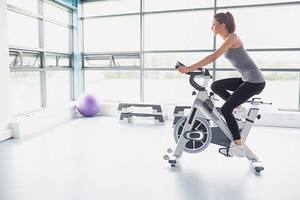 An exercise bike is a great way to practice HIIT.
An exercise bike is a great way to practice HIIT.
Its resistance settings allow you to manage the intensity of your workout.
The bike also lets you measure the speed at which you pedal.
During your workout, aim for a speed of 90 revolutions per minute and slowly increase the pace until you reach 110 revolutions per minute.
The built-in timer on most stationary bike models also makes it easy to monitor exercise time.
2. Jump
If you haven’t touched a skipping rope since school, then it’s time to get back into it!
Jumping rope is a highly effective cardiovascular workout for both the upper and lower body.
Today’s skipping ropes are lightweight and flexible. And to motivate you, athletes, boxers and footballers all jump rope for a quick boost.
Several studies have shown that skipping protects against osteoporosis and helps reduce blood pressure and cholesterol levels.
Jumping is a less demanding exercise than running, yet it burns more calories per minute!
Skipping is a workout you can do at home. It’s easy, fast and complete, as all you need to do is keep your torso straight, your knees and ankles bent, turn the rope from your wrists and forearms and try to keep your feet as close to the ground as possible.
3. Climbing stairs
 Stairs are everywhere, so this is a HIIT workout that’s accessible to everyone.
Stairs are everywhere, so this is a HIIT workout that’s accessible to everyone.
Running up stairs gives you the same benefits as a classic run, in half the time.
How do you do it?
Simply because when you climb stairs, you’re working against gravity. This makes the exercise more intense and helps tone your legs and arms.
However, no matter how innocuous this movement may seem, you need to make sure you’re using the right technique.
First, try not to lean forward or lower your head.
Next, bend your arms at right angles to give yourself the power to climb the steps.
Make sure your whole foot lands on each step to avoid straining your tendons.
Recover by reducing your pace on the way down.
As with any fast home workout, the principle is to move as quickly as possible.
Move fast, you should feel the burn in your legs. You’ll then recover on the way down.
Listen to your body and your heart
Your resting heart rate is the best indicator of the state of your health.
According to science, people with heart rates above 70 beats per minute are the most likely to have a heart attack.
Regular exercise lowers your heart rate, helping to prevent cardiovascular problems. Top athletes can have a resting heart rate of 40 beats per minute.
Rapid home training Strength programs
To stay fit and healthy, you need to exercise not only your heart and lungs, but also other major organs such as your muscles.
Rapid strength training can be performed at home using only your body weight or a simple resistance band.
Below are 10 different exercises designed to improve your endurance and strength. The aim is to do one of them for a duration of 30 seconds, followed by a 10-second rest period.
Try to do as many repetitions of each exercise as you can during these 30 seconds, while making sure you do them correctly and maintaining the correct posture.
On average, you should do between 10 and 20 exercises, and the total duration of your workout should be around 7 minutes.
The basic idea is to work the different muscles of your body, alternating activities so as to reduce rest time for the muscles that work the least.
The order of the exercises is important only insofar as you need to consider the intensity of each exercise in relation to your heart rate.
NOTE: If you suffer from high blood pressure, you should avoid exercises such as the wall sit-up and plank.
Consult your doctor before beginning this series of intense exercises.
1. Star jump
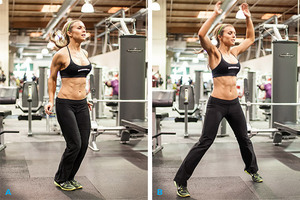 The star jump or jumping jack is a fitness exercise that works many of the body’s muscles and promotes fat loss.
The star jump or jumping jack is a fitness exercise that works many of the body’s muscles and promotes fat loss.
It’s a simple exercise that involves jumping with your arms and legs apart at the sides.
With your arms at your sides, in a single movement, jump up and spread your legs, raising your arms above your head.
You should land with your arms still above your head, and the gap between your legs should be wider than your hips.
In a single movement, jump up again and bring your legs together, bringing your arms to your sides.
Continue for 30 seconds.
2. Exercise sitting against a wall
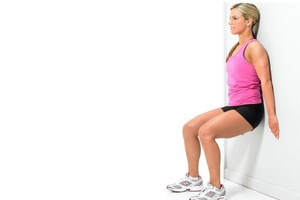 This technique is static. In other words, there’s no movement involved.
This technique is static. In other words, there’s no movement involved.
It’s an exercise designed to work the buttocks and thighs in particular.
Start by placing your back against a wall, with your feet shoulder-width apart and about 60cm from the wall.
Gently slide your back until your thighs are parallel to the floor.
Make sure your knees are in line with your ankles (not your toes).
Keep your back straight.
Hold this position for 30 seconds if you can.
3. Chair exercise
Use a sturdy chair with a comfortable seat height so you can stand on it.
Place one foot on the seat, making sure the whole foot is in contact with the surface.
Push your weight upwards. Try to channel your weight through the heel until you’re fully upright on both feet on the seat.
Step back and lower one leg at a time.
Here you are again, both feet on the floor.
Repeat using the other leg. Do this exercise for 30 seconds.
4. Squats
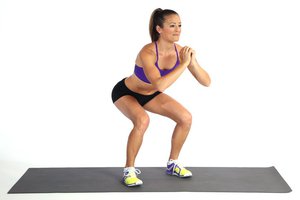 Stand with hands stretched out in front and peids shoulder-width apart.
Stand with hands stretched out in front and peids shoulder-width apart.
Bend at the hips, keeping your weight on your heels. Make sure your back remains straight.
Keep flexing until your legs are at a 90-degree angle.
Imagine you’re about to sit in a chair. Push back and straighten your legs without bending your back.
Repeat for 30 seconds.
5. Dips or backward push-up
Dips are ideal for the arms and triceps in particular. Partly similar to the squat, this technique targets the upper body. Dips are a flexion-extension movement of the arms.
Lean your hands back on a chair placed behind you. Hands should be shoulder-width apart. Legs straight and tight, buttocks in the air and only the heels in contact with the floor.
Lower your body gently into the void by bending your arms. Your weight should rest solely on your hands and arms. Stop lowering when your arms form a right angle.
Then start lifting your body until your arms are straight and taut again.
Repeat for 30 seconds.
6. Knee raises
The knee raise is an ideal cardio exercise. It accelerates heart rate, melts fat and eliminates love handles.
In fact, it’s like jogging on the spot.
Without leaning back, run on the spot for 30 seconds, trying to get your knees as high as possible at chest level.
Swing your arms back and forth, keeping your hands relaxed, elbows bent and shoulders down.
7. Lunge exercise
Stand with your back straight and feet shoulder-width apart.
Move one leg forward, bending both knees to form a 90-degree angle while keeping your upper body straight.
Return to the starting position and repeat with the other leg.
Do this for 30 seconds.
8. Side planks
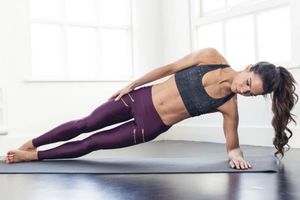 Lie on your side and raise your body by supporting your weight with one of your forearms and your feet.
Lie on your side and raise your body by supporting your weight with one of your forearms and your feet.
Keep your body straight with your hips off the floor. Keep your neck and back straight.
Raise your arm so that it’s perpendicular to the floor, and lower it again until it returns to its starting position alongside your body.
Repeat for 30 seconds.
9. Plank with leg raise
Assume the plank posture.
Your body is kept elevated by placing your elbows on the floor, with your weight distributed between your forearms and feet. Your elbows should be bent at a 90-degree angle.
Keep your back straight and your hips off the floor.
Tighten your torso and slowly lift one foot to a height of 15 or 20 cm.
Hold this position for a few seconds, then lower your leg to return to the starting position.
Do the same with the other leg.
Repeat for 30 seconds.
10. Reverse curl
Lie on your back, arms at your sides, legs bent and feet on the floor.
Move your pelvis to raise your hips off the floor.
Your legs should now be at 45 degrees to the floor.
Hold this position briefly.
Slowly return to the starting position.
Repeat for 30 seconds.
Now that you’ve read this article, you’ll be able to enjoy all the benefits of HIIT without leaving the comfort of your own home.
Exercise is a key factor in any weight-loss programme.
Keep motivated and keep exercising. It won’t be long before you see the results. Keep up the good work!
Also read
Burn 300 calories in just 10 minutes with these exercises
Here are some examples of moderate activities that will help you burn 300 calories, provided you have… Read more…
